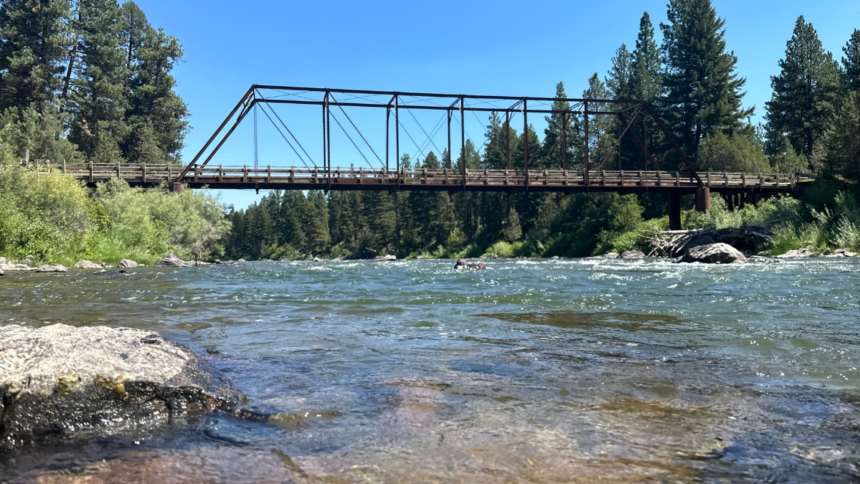Montana Fish, Wildlife and Parks has implemented fishing restrictions on 13 western Montana rivers that are exceeding temperature thresholds following an underwhelming snowpack and a heat spell last week that broke records in some parts of the state.
The list includes both low-flow rivers that see hoot owl restrictions more years than not, such as the Big Hole, Beaverhead, and Jefferson rivers, and other, higher-volume rivers that typically hold onto enough water to stay open for afternoon angling later into the summer. These rivers include the Bitterroot, Clark Fork, and Gallatin.
Per the “hoot owl” restrictions, fishing is prohibited after 2 p.m. Some rivers, such as the Big Hole and Bitterroot, are closed along their entire length, while other closures apply to specified segments.
Pat Saffel, Region 2 fisheries manager for FWP, told Montana Free Press that precipitation in May and cooler temperatures in June gave western Montana rivers a couple of weeks of reprieve, but “now that the rain has stopped, we’re dropping fast.”
“Now we’re paying the price of not having the snow,” he said.
Saffel said he’s particularly worried about the Blackfoot River, which typically escapes hoot owl restrictions even as they’re enacted in nearby rivers. Not this year, though: FWP put the Blackfoot’s lower stretch into hoot owl restrictions on July 11. Per the U.S. Geological Survey stream gauge near Bonner, the Blackfoot is flowing at 575 cubic feet per second on Thursday, a third of its typical rate.

Unfortunately, conditions aren’t likely to improve in the coming days, according to Missoula-based National Weather Service meteorologist Jeff Kitsmiller.
Kitsmiller said that the same high-pressure system that brought record-setting high temperatures to Missoula last week is likely to stay through the weekend. NWS models are calling for above-normal temperatures and below-average precipitation into early August.
“This is definitely going to continue to [cause] problems with warming water and low streamflows,” Kitsmiller said.
Citing low stream flows and water temperatures above 68 degrees, Yellowstone National Park also announced last week that three rivers inside the park boundary — the Madison, Firehole, and Gibbon — and their tributaries will be closed to angling for the foreseeable future. The park also noted in a July 12 press release that additional closures may be necessary for other rivers in the park.
ADAPTING TO A CHANGING CLIMATE
Michael Downey, drought program coordinator with the Department of Natural Resources and Conservation, said he’s bracing for a widening and deepening of the drought that’s pinching water resources in western Montana. Downey said it’s likely that the Blackfoot River basin will transition from severe drought to extreme drought before the summer ends.
“We’re seeing these much longer periods between big storms. Then we’ll get big storms, and it will be dry, dry, dry,” Downey said. “I do think that will have ramifications for what [crops] we’re going to grow and, ultimately, what our landscape looks like.”
This season is falling into a larger climate change-driven pattern of extremes that former Fish and Wildlife Commissioner Pat Byorth said he’s been seeing more and more — rivers experiencing higher, earlier runoffs that last for a shorter period. Montana’s famed trout struggle to keep cool when a truncated runoff is followed by a string of hot, dry weeks, said Byorth, Trout Unlimited’s Montana water director.
RELATED

Trout in trouble
Anglers come to Montana in droves for the abundant wild trout. But this summer’s rising temps, dropping flows and declining brown trout populations could harbor clues about the future of the state’s celebrated cold-water fisheries.
“During stressful times, [fish] could seek out nooks and crannies of groundwater upwelling to help them get through that period, [but] as the hot time goes on longer, it’s harder for them to eke out a survival,” Byorth said. “It used to just be a week or two, and they’d adapt. They’d find refuge in tributary streams or move up to cooler water.”
What’s harder for them, he said, is enduring six weeks of high temperatures, which can wreak havoc on their metabolism and cause their cells to malfunction.
“They may survive, but even if they survive, they go into winter, the other really hard season for them, in much poorer shape,” Byorth said.
Byorth said that’s one reason it’s important to restore and protect features that will support cold-water fisheries, particularly given the outlook for Montana’s cold-water fisheries, which is troubling. That can mean working with water rights holders to keep more water in key tributaries or restoring beaver ponds and wet mountain meadows to bolster summertime streamflows, he said.
The fishing industry is also adapting to more challenging streamflow conditions, according to Fishing Outfitters Association of Montana Executive Director Mike Bias. Fly-fishing guides and their clients are shifting away from afternoon or all-day outings to morning trips during the hottest months of the year, and he’s been encouraging his clients to consider trips in the spring and fall when water temperatures are cooler.
Another measure that can mitigate challenging streamflow conditions is FWP’s use of Murphy Rights, state-held water rights established more than 50 years ago to help 12 of Montana’s blue-ribbon fisheries through lean water years. Rights were established to support specific reaches of iconic rivers such as the Blackfoot, Flathead, Gallatin, Madison, Missouri, Smith, and Yellowstone rivers.
Those water rights, named after James E. Murphy, the state lawmaker credited with their creation, aren’t particularly old water rights. That means that asking junior water rights holders to stop their water withdrawals might have little, if any, impact in basins with lots of large, old water rights.
But Bill Schenk, FWP’s Land and Water Program coordinator, said Murphy Rights do have a role to play in the water management dis
cussion.
Late last week, the department used its Murphy Right on the Blackfoot as authorization to mail letters to dozens of junior water rights holders on the river asking them to cease using water. The department won’t make a similar request for domestic water uses, so most of the shift will occur — provided the contacted water rights holders cooperate — in crop irrigation and lawn watering.
Schenk added that he anticipates 12 of the rivers for which FWP has Murphy Rights will meet the basic flow thresholds this summer that authorize the department to ask more junior water rights holders to cease withdrawals. It’s not a hard-and-fast rule involving streamflows alone, though, Schenk said. The department often decides against requesting other users stop their withdrawals in situations where the Murphy Right is too junior to matter by the time the flow threshold has been triggered, or if dam management complicates the streamflow levels and planning considerations in play.
“There are individual circumstances to look at around each and every source,” Schenk said.
Ultimately a recommendation will be made by personnel within the department — a fisheries biologist and in-stream flow specialist, typically — and forwarded to FWP Director Dustin Temple, who will make the final call.
Shenck said the department is considering using a water reservation, which is similar to a Murphy Right, but with a more junior priority date, for the Big Hole River, which crested at 75 degrees — a critical temperature threshold for trout — on July 9 and is running at about one-third of its normal rate.

The full list of rivers with a closure in place as of July 18 are:
- The Beaverhead River: Hoot owl closure from Highway 41 near East Bench Road to its confluence with the Big Hole
- The Big Hole River: The entirety of the river is under hoot owl restrictions
- The Bitterroot River: The entirety of the river is under a hoot owl closure
- The Blackfoot River: Hoot owl closure from Cedar Meadow Fishing Access Site to the confluence with the Clark Fork River
- The Clark Fork River: Hoot owl closures in place from the mouth of Warm Springs Creek to the confluence with the Flathead River
- The East Gallatin River: Hoot owl closure in place for the entirety of the East Gallatin
- The Gallatin River: Hoot owl closure from Amsterdam Road to the confluence with the Missouri River
- The Jefferson River: Hoot owl closure from the confluence of the Big Hole and Beaverhead rivers to the Missouri River
- The Madison River: Hoot owl closure from the footbridge at the NorthWestern Energy powerhouse (downstream of the Madison Dam) to the confluence with the Jefferson, and from the Ennis Fishing Access Site to Ennis Reservoir. There is also a full fishing restriction in the short section from the Madison Dam at Ennis Reservoir to the footbridge at NorthWestern Energy’s powerhouse.
- The Ruby River: Hoot owl closure from Duncan District Road to the confluence with the Beaverhead River
- Silver Bow Creek: Hoot owl closure along the full length of the creek
- Smith River: Hoot owl closure from Eden Bridge to the confluence of the North and South Forks of the Smith
- Sun River: Hoot owl closure from the mouth of Muddy Creek to the Highway 287 Bridge





